Summer is getting closer and closer, and maybe you are already planning something. Maybe a visit to your family, a week in an amusement park or even a trip somewhere. Perhaps the choice for your trip will be summer-like countries, such as Italy, France or Spain. You can walk through the many streets of Barcelona, eat good ice creams in Rome, or try to find the best lavender soap in the South of France. In this special region of France there is also a special show you can decide to discover: race , the famous bullfighting show comes straight from Spain. Very popular in the South of France, race the organization is in a bad state since the Covid-19 crisis; arenas that welcomed the audience are closed, no shows and no financial aid are planned for now.
Depending on your age and experience, you may think that this show is pure cruelty to animals. It is completely understandable; In fact, I thought just like that when I was younger. But one day, since I saw my 9 th bullfighting program and had the opportunity to go behind the scenes in breed , I discovered the world (the bullfighting universe), where fear, bravery and spirit are everywhere.
I want to explain it to you, not to make you a great enthusiast (a corrida lover), but as a way to remember what corrida really is:not a cruel victim, but a fight between the animal and the man.
History
Ox

Men have always been fascinated by the bull. Since prehistoric times, he was depicted on caves on walls and hunted for human survival. The bull has even been referred to as a mythical creature in various civilizations (the Minotaur in Greece, the god Apis in ancient Egypt or even Mithras, the mysterious Persian cult involving an ox that looks like a deity).
The representation as a large and strong creature shows the respect he receives from men. Therefore, it was inappropriate to tame him. This is why the bull in Spain is referred to as Toro bravo . It is believed that the bull migrated from Eastern Asia to Western Europe, until it reached the Iberian Peninsula. In the Middle Ages, toro bravos were so numerous that no one worried that this species would disappear, even though it could have happened.
The bravery of the bull is not a myth. It was very important; If you enter the territory of a bull, you run better as the bull will charge. This is how men developed traditions and what they called bullfighting (every game involving bulls). These traditions are still very popular, such as the Camargue Race, the abrivado or blocking (the famous race in Pamplona)
The birth of race
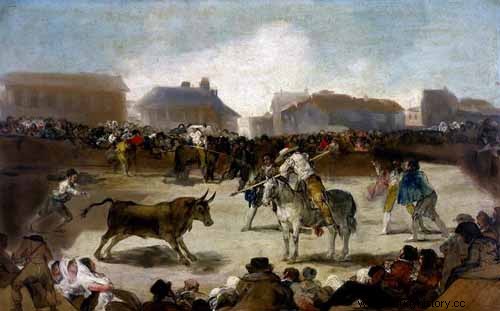
This is not a surprise, but race has its origins in the Iberian Peninsula. Visigoths can be seen as the forerunners of bullfighting games, as it was a tradition to hunt wild bulls. The Muslim invasion of Spain brought many things, especially great knowledge in riding, which has a great place in bullfighting today. It made bulls easier to hunt. Equestrian knowledge was complementary to traditions in Asturias. The idea of corrida then comes from northern Spain.
Bullfights were extremely popular in the Middle Ages. It consisted mainly of chasing oxen on foot and killing them with a spear. The bull killers were then called matatoros (the ancestors of matadors ).
The newborn bullfighting , present in Spain, but also in France, Italy and even England, was reserved for the nobility. I 18 th century, Philip V, the future king of Spain, was not a race fan. His lack of experience in this area made him see bullfighting as a cruel activity and ban it. However, as he was too busy to assert his authority, the horse with the corrida never disappeared when ordinary people began to practice this activity. The grooms ( Peon in Spanish) gained more power in the arena and became as good as nobles in the art of bullfighting. The first groom to be considered a bullfighter (a matador is the main bull effects under a corrida) is Francisco Romero, whose grandson added many elements to bullfight (the struggle and its treatment). He killed the bull only with a crutch (the cloak) and a sword, on foot and without a horse.
Breeding farms and litters
Bulls for breed kept in what is called a " ganaderia ”. It can be translated as a beef breed. Around the world there are around 1700 ganaderias and among them are 1175 Spanish. Other ganaderias found in Mexico, France, Portugal, Peru, Ecuador and Venezuela. In Europe, 30,000 male toros-bravos are born each year. Among these creatures, only one in six will be sent to the arena.
The universe of race works in casts, mainly when we talk about the genetics of bulls. As history has shown, Spain is not just made of Spaniards, and so is oxen. Therefore, various casts were made around Spain, which made it possible to identify bulls. The casts were created around the end of the Middle Ages, when bullfighting was more sedentary, which meant a selection among the bulls. Today we count six great throws in Spain.
Two of them, Raso del Portillo and Jijon is located in Castilla. The other four, Cabrera , Vistahermosa , Vazquez and Gallardo is from Andalucía.
A beef life before the match
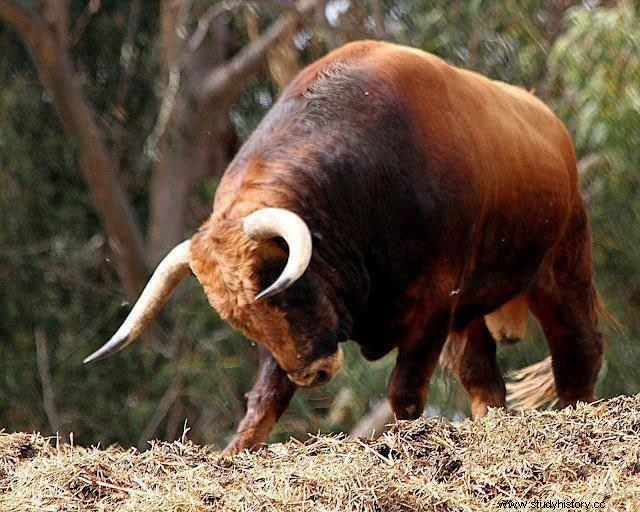
The love of farmers (the breeders of the bulls) for their bulls is obvious. Corrida is still such a sacred institution that if a breeder had the idea of weakening or treating his animals, his reputation would be dulled forever.
The bulls destined for the battle in the arena are born in a ganaderia . They know nothing but the environment. And it's not the worst thing in the world; the bulls are completely free and develop in an almost wild environment, unlike other bulls that are kept for meat consumption. ran bulls have a luxurious life, away from men and completely free. A single bull can have one hectare to itself, while a consumer board only lives on a 5 square meter space for the rest of its life.
Ganaderos must take care of their bulls; they look at the vaccination and the brand, make sure they are in good health and also try to avoid fights as much as possible. Like when an ox goes for a corrida, five others are rescued from the show. But when matches (wild bulls fight) happens, the most dangerous can make ranches loose more than one ox. Most of the time, the two bulls involved in the fight can kill each other. Then another bull must be selected for the corrida. The bulls for race is selected in probe (a small arena in ganaderia ) where the grooms stimulate them to show their strength and bravery.
The bullfights
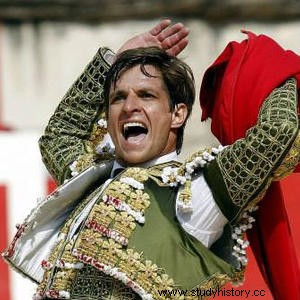
Ok, I'm sure you can portray a bullfighter in your mind, with a flashy suit a large red cloak.
Today, bullfighters is educated in special schools. They first train with cows (feisty cows) and have several trainings, including a fight without execution or with a very young bull. After that, the young trainee can be invited to a bullfight (a fight between a young bull and a young torero). If he is good enough, he must meet older bulls. After 25 matches like these, the young trainee can pass his "alternative". It's like a doctorate passed in front of an audience and with two matadors by his side as godfathers and witnesses to this ceremony. The young bullfighter gets matador's costume in this moment and kills the first and last bull of breed .
The worlds also has an important place in the life of a matador . With good relationships, matador can see his carrier being radiant or crushed to the ground. The matador then you can fight bulls in the biggest arenas in the world with brave bulls, or get caught in a small arena with a dangerous Miura (the bulls of Miura are known to be the most dangerous of all).
Corrida ulcers are very common and can be fatal to matadors . This is an aspect of corrida we tend to forget, as the general perception of bullfighting focuses more on animal suffering. But a strike with the horns of an ox leaves important consequences, physical and mental. For example, matador Juan José Padilla suffered three major injuries in the carrier. In 2011, he was tapped on the left eye, and generated major problems in the upper jaw and auditory injuries. A year later he was tired in his left eye again, but the eyelid saved him. And in 2016 an ox shelled him. Since then, Padilla has been nicknamed the "pirate" by fans, and you know he will fight in the arena when you can see pirate flags in the crowd.

How does a corrida take place?
The ri
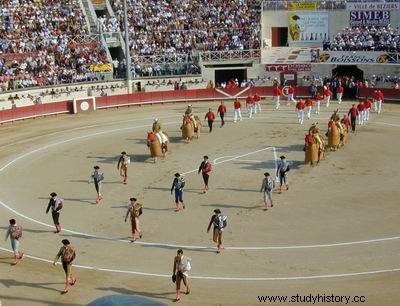
Most of the time, a race starts on time. Before the match, a procession called ri , enters the arena. As bullfighting is legal in Spain, the presence of a president is crucial for corrida.
Once the music has started, alguaziles will (symbolic representation of the arena's justice) enter the arena to greet the president. Then they go back to where they came from and wait for the president's order to let bullfighters write.
On the first line are the three matadors who will fight. The one on the left is bullfight boss, the first matador, as he is the most experienced. At the center is the most inexperienced matador , who will fight last, and to the right matador who will fight in second place. The second line consists of the first matadors gang (consists of three bullfighters who will fight the bull with the matador). The third line is the second matador's gang and the fourth line, gang of the third matador .
Behind them will follow the six picadors on their horses, those who will stab the bull to weaken him during the first third (action). They are followed by the groom, called monosabios . Then the procession ends with the entrance to the sandboxes (responsibility for cleaning the ground of the arena) and " pull ”(Two mules that will carry away the ox's body when the fight is over).
After the procession, became matadors prepare themselves and picadors leave the arena. Then, an alguazil will give the key to the bullpen to the arena owner. Then everyone must leave. Cowbells are ringing, the bull is open and the first bull is coming soon.
Corrida's actions
ACT 1:Tercio de Varas ("part of lances")
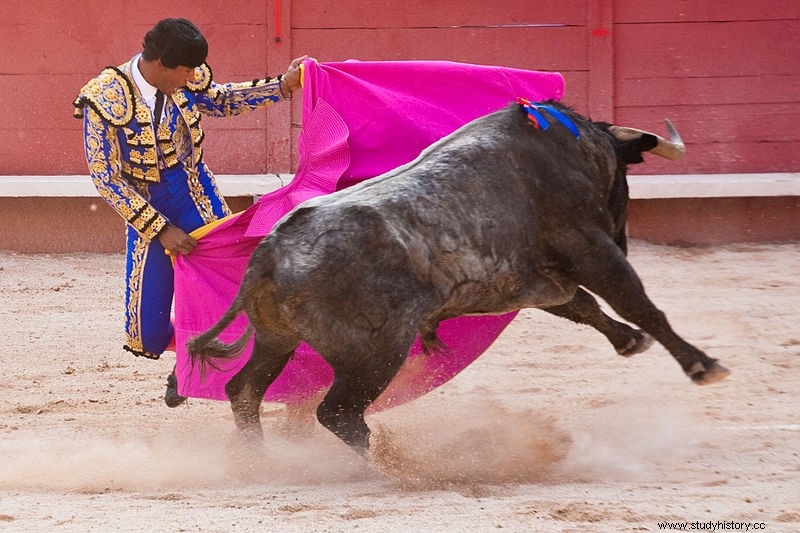
The bull has entered the arena and the fight can begin. The matador uses this third to observe the bull and how he reacts to provocation. And then matador must plan bullfight to slowly take advantage of the animal. He makes various " passes ”(Passes with crutch ), first simple, then more aesthetic.
The matador must be smart and careful, as it is not natural for a human being to stay still when a 500 kg muscular animal is charging towards him (I would have run 3 kilometers away). Under this tercio, matador uses a trilogy rule:" parar-mandar-templar ”(Block-makes obedient- calm down). He must block the bull while standing still. Then he must get the bull's attention and get him to charge. The man begins to gain more control over the animal. Then he must be in harmony with the bull.
After several passes between the bull and the matador, a picador enters the arena. Picadors is the scrum of a rugby team; they have to do the ungrateful business of making matador win. How is it an ungrateful business? Because no one gets as close to the bull as picador .
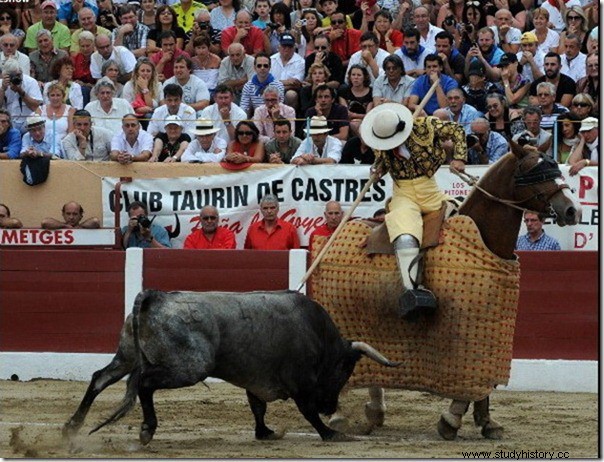
Today, the pike are recognized for having removed the bull (since he has entered the arena, his blood pressure is very high). Although this show is cruel to some, it is necessary. And in fact, the amount of blood the bull loses during this action is equivalent to a human blood test. If too much blood falls, picador will being bent. Because it can show his incompetence, and matador's , to act properly. Another proof of his incapacity is that he punches the bull with all his body weight or aggressively (the audience reacts quickly, dissatisfied with this free torture).
The picadors the job is very dangerous; contrary to matadors and their cuadrillas , the picador enters the arena and rides a horse. The horse has the body covered with a special protection, so he will not be injured when the bull charges. But sometimes, picador and his horse may be the victim of a thump from the bull. AND dunke is always very impressive; the bull is so strong and brave that he can overturn picador , but also the horse.
ACT 2:Tercio de Banderillas ("part of a little flag")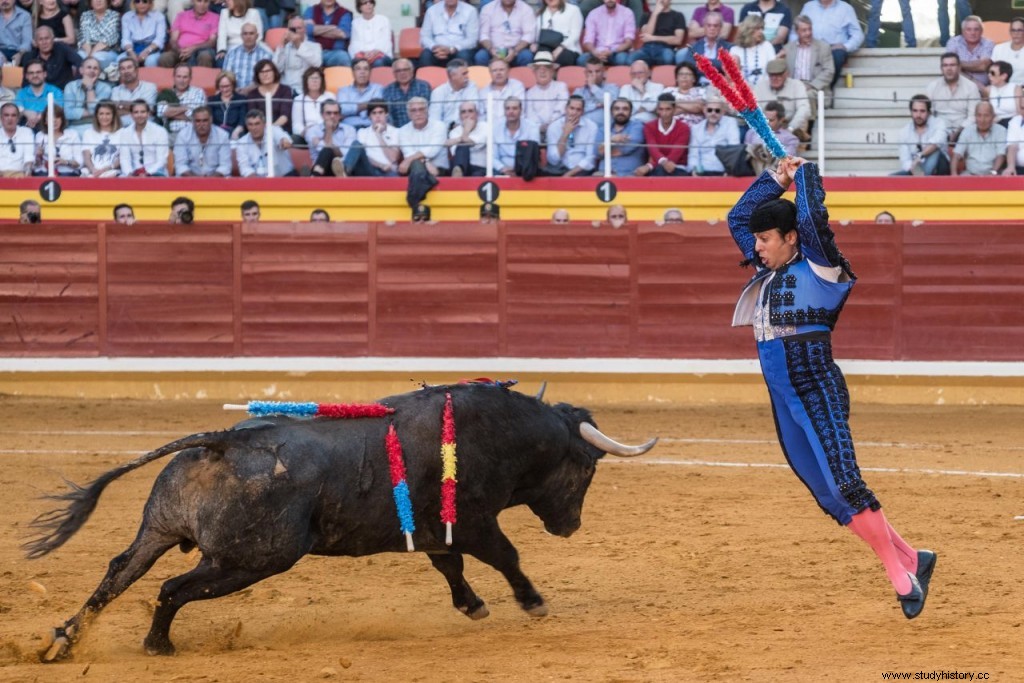
Som picador and his pike, the tercio de banderillas is not as popular as it used to be. This third requires great knowledge and capacity to wear the bull, but without wearing him. And most of the time, banderilleros (which drives the banderillas on the bull) are not perfect at it. The banderillas is often misplaced, and weakens the bull far too much. The goal of banderillas like picadors pike, is to weaken the bull enough that he can not lift his head (otherwise it would be too dangerous). Between 2 or 3 pairs of banderillas must be inserted on the bull. If the bull is still brave, the matador will may decide to add a fourth.
ACT 3:Tercio de Muerte ("part of death")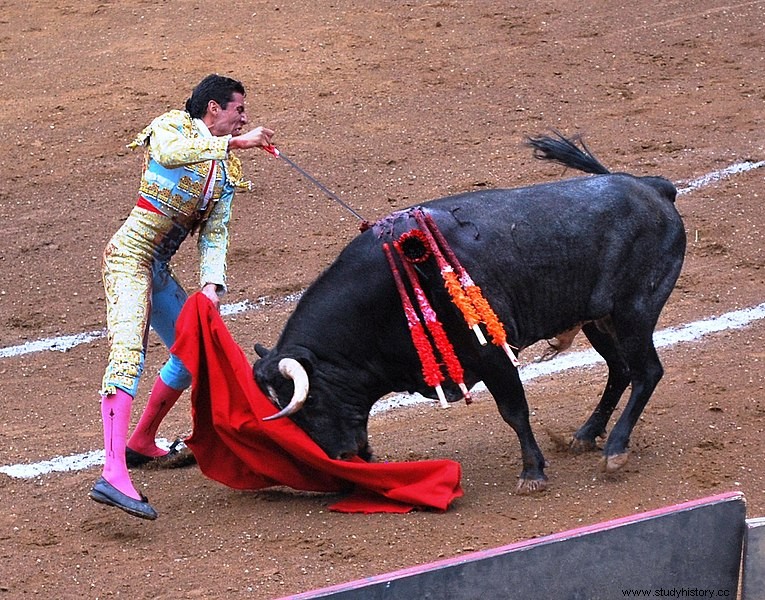
It's in this section the real traditional red crutch see you later. This tercio will end with the death of the bull (or, in very rare exceptions, his grace).
Respects parar-mandar-templar rule, the matador make several aesthetic passes (some of them include lying on one leg, pushed forward while bringing the bull towards the muleta). Aesthetics here are crucial; it shows the matador's bravery and technique. Many items can make a passport look bad, such as a copy-paste on a fellow matador, lack of mercy or repetition.
After trimming and ornamentation passes (when the bull gets so close to the matador that he can have full contact with him), it's time to push ; the death blow. The matador takes a steel sword to perform " supreme suerte ”. While this moment can be horrible for the bull, it is also extremely dangerous for the matador . An ox, even a weak one, is still a wild animal and will not stop to defend its territory.
When ready, the matador has a few chances to make a perfect death blow. Killing the bull at once will give matador prestige. Trying to drive the sword in the back for 6 th time will get him boos. To kill the bull properly (that is, without inflicting too much pain on him), the sword must be driven inside the bull's back, in a special place called “la cruz” (the cross), between the shoulder blades without damaging the vertebrae. Sinking the sword completely into the bull will cut the posterior aorta and the posterior vena cava, and stop cardiac activity. The bull's death is then immediate.
But unfortunately it is very rare that matador sticks the aorta and vein together. Most of the time, they sting the lungs or other arteries, insuring the bull's death, but not as fast as it should be. If tercio lasts more than 15 minutes, it will be considered bad.
Trophy
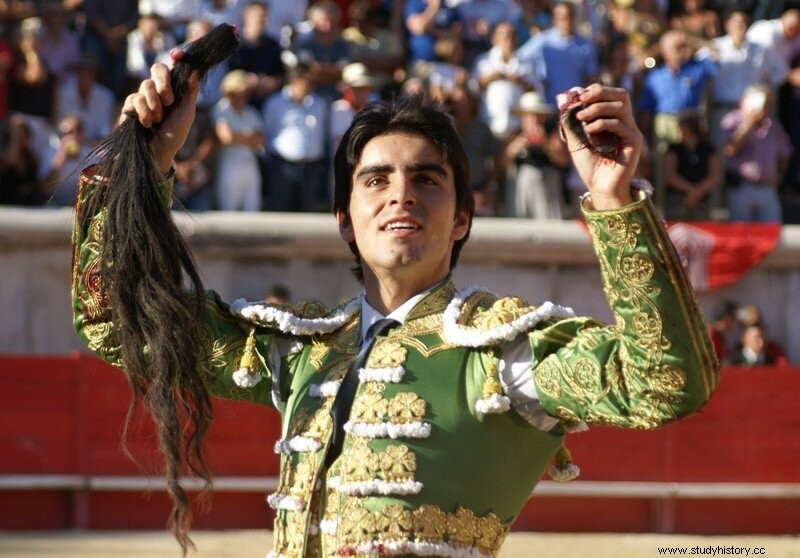
After the bull has been hit by the sword, the gang will destroys the bull's cerebellum and arrests take away the body.
According to the time it took him to kill the bull and all his actions and decisions during bullfight the matador can get a trophy, which is the ears and tail of the bull he just fought against. Although the decision to give a trophy to matador is the president's decision, the public's opinion can gain the upper hand. They just have to wave a white tissue in the air to express this auspicious perception of a trophy. But with the audience's growing ignorance of bullfighting and the remote-controlled jury, opinions are strongly divided, and one sees a matador to be rewarded is extremely rare.
Getting one ear was proof that the death blow was very well done. It is often called the "public ear", as it is thanks to them that a matador can get it. Having two ears shows, according to the presidency, a great deal of knowledge and strength during bullfight and the death blow. Finally, it is extremely rare to see a matador be rewarded with two ears and a tail. The tail is the symbol that the tercies were perfect and the bull brave enough to withstand the fight, and make it more spectacular. It's proof that matador took the risk to end the fight, as today the first ear is given too easily to matadors. The motto "victory without risk brings triumph without honor" is perfectly illustrated with today's first reward in bullfighting.
The Grace of the Bull
In the 1920s, the grace of the bull was extremely rare, almost impossible. But today the rules have changed. The grace of the bull can come from the audience; if the bull is too difficult to kill, the audience can wave their white tissues in the air to ask for the animal's mercy, and save him from death. The young novice is often happy to see a bull rescued from the death blow, but this grace is only symbolic.
A gracious ox from a corrida is often without luck. He may have been brave, but he has now lost a liter of blood and is extremely weak and injured. Depending on the matador's ability to make a fatal blow, he may have had severe cuts to his back and holes in his lungs. The only one who saved him is still death.
The fact is that every year a few thousand bulls are killed in one arena; it allows hundreds of thousands of others to stay alive. It was proved that without corrida breeding of bulls would never have existed. And then, the nature of toro bravo would have disappeared a very long time ago.
Does corrida still have a place in today's society?
Detecting corrida and bullfighting is not traumatic for a child if you are with benevolent experts. It is simply seen through the eyes of a child as it is presented:a show. You have fans around you who tries to explain to you how the fight works, how a matador should kill a bull properly without making him suffer.
With movements for animal rights today, more people tend to see corrida as a crime against wildlife. It is blood, executions and above all suffering. Every opinion is different, and they are many when it comes to bullfighting. They can be grouped into two categories:pro-corrida (reunion of most fans ) and anti-corrida. But while fans are seen as cruel and voyeuristic, the struggles led by anti-corridor movements are so extreme that they are unlikely to be recognized. They are even seen as hysterical.
In fact, if you want to know about race is good or bad, it is even difficult to get that answer:researchers who studied the bull's disorder during the killing process disagree with each other. Although some may pretend that the suffering is the worst that can be experienced, others can, thanks to the technique taught in bullfighting schools, prove that the animal does not suffer. They may even defend the fact that when the murder process is too long or poorly executed, the matador will is bent by the audience.
What we tend to forget in debates like this is that everyone is free to believe in their own principles, whether these are traditional or more progressive. Fans are traditional lovers, as corrida is one of the brightest elements in Spanish culture. It has a history, a method, and an entire organization has built around it, provided jobs, generated passions and created a notion of belonging to a community. When we tend to discover what corrida really is, it turns out that it is not just an execution. It is a demonstration of strength between two creatures:one who has trained all his life to fight a beast, and one who has not been in direct contact with a man, and ready to defend its territory, with all the bravery and courage that characterizes him.
